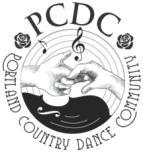By Bryce Holt, Contra Committee Member, and Lori Shaffer, PCDC Newsletter Editor
Hello contra community! In our continued goal of looping more people into an activity we love, let’s look at some ways we can increase feelings of inclusion and encourage the rapid learning of contra dance skills. Most, if not all, of these observations and suggestions have come from the contra dance community.
If you’re a more experienced dancer, sharing your skills is something to aim for. Increasing feelings of comfort and inclusion in newer dancers is a wonderful way to build community. And encouraging the growth of dance skills and the community as a whole increases both our enjoyment and our community’s viability in the long run.
Do you remember your early dancing days? Lining up and finding your next partner can be quite daunting. As a newer dancer, selecting a very experienced partner can make all the difference. However, it’s easier for experienced dancers to spot newcomers than the other way around.
One way we reduce the prep time between dances and make sure to snag a partner for the next dance is to look for a partner close at hand. We typically do this at the close of the previous dance. However, this time can go by too fast for a newcomer lost in a sea of unfamiliar faces, often leaving them on the sidelines or at the end of the line (where they may not be able to hear the caller well or participate in a full walk-through). Again, it’s easier for us regulars to spot them, rather than the other way around. Try looking for that new person who looks a little lost.
Newer dancers don’t always realize that they won’t participate fully in the walk-through if they’re spit out at the end of the line. One thing that seems to work is to form (or relocate) one or two hands-four groups of seasoned dancers at the end of the dance line. This moves the newer dancers into the middle of the group. Being closer to the stage allows newer dancers to hear the caller better and see better as well. It also allows the caller to better keep an eye on them and provide additional help if needed.
The socialization part of contra is wonderful. Saying hello is a great idea, and after that, checking in about role preferences, physical limitations, energy levels, and desires for the dance is important. You can then round out the conversation if there’s time before the walk-through. But if you’re trying to catch up with friends during the walk-through, consider taking yourselves toward the back of the hall while encouraging the newer folk to scoot forward, putting them another step closer to literal inclusion and increasing their ability to hear the caller. (Or better, consider catching up with friends outside the dance entirely, so you don’t interrupt the caller and the flow of the walk-through or the dance.)
Can we think about the variety of community members we encounter at our dances? Contra dancing provides built-in opportunities for getting comfortable with different types of people. Mixing with different sorts of people allows us to appreciate one another as individuals. In my experience, our commonalities far outnumber our differences, so in the end, we have the luxury of connecting with people we might not have otherwise interacted with. This increased potential for relating to others is yet another benefit of our highly interactive and egalitarian dance form. It’s something we can (and do) take with us outside of the dance experience.
In the end, we are all individuals, many of us with complex lives. Some of us come to a dance simply to lose ourselves in the music and dance and take a break from the challenges and rigor of schedules and commitments, and that’s great too!
Thanks for being a part of the conversation about growth and inclusion. I’d like to tip my hat to those who are working diligently to grow this dance form by adding helpfulness and inclusivity to their bag of dance tricks.
